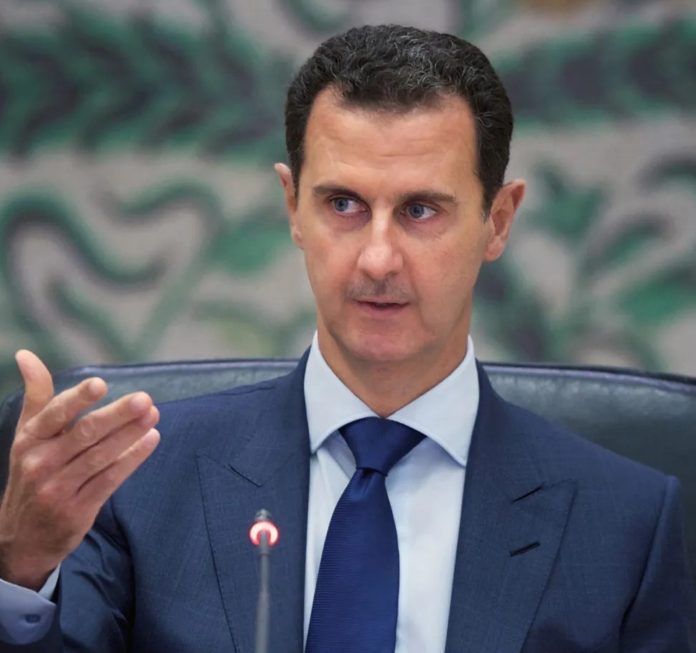The Syrian conflict is in its seventh year due to which more than 465,000 Syrians have been killed in the fighting while more than a million have been injured. Over 12 million Syrians, half the country’s prewar population, have been displaced from their native lands and homes.
US and Russia Joint Statement
Recently, the US and Russia agreed on a joint statement which was devoted to the cease fire in southwest Syria, this was initially agreed to in July 2017. Both countries agreed that “military solution” would not be ideal to the conflict in Syria. It included the reduction and ultimate elimination of foreign forces and foreign fighters from the area to ensure a more sustainable peace in Syria. U.S. President Donald Trump said that an agreement with Russian President Vladimir Putin on Syria would save many lives. Both have agreed to promote a political solution to the conflict through negotiations to be held in Geneva. The joint statement also called on all conflicting parties in the Syrian war to be part of the Geneva peace process, which strongly implied the inclusion of the Kurdish Democratic Union Party (PYD), the YPG’s political wing.
New Joint Statement and Conflicting Realities
The joint statement has been taken differently in the Middle East and MENA due to conflicting geopolitical and geostrategic priorities of the regional as well as international countries.
Strategic Blow to Turkey
Turkey one of the main players in the ongoing war in Syria showed its dissatisfaction and displeasure as this totally ignored its vested interests. It is indeed a “strategic blow” to Turkey as the U.S. – Russian joint statement made no reference to Turkey and the Idlib de-escalation zone, while Jordan, in sharp contrast, was referred to as part of peace efforts in southern Syria. Apparently, Turkey has been left out from the war of Syria. It countered Turkish plan to move militarily against Kurdish militia in Syria’s Afrin by excluding them from the peace process and eliminate Syrian President Bashar al-Assad as illegitimate.
Turkish President Recep Tayyip Erdogan’s Statement
Turkish President Recep Tayyip Erdogan also expressed his dissatisfaction with the joint statement which excludes military option, except against the Islamic State (IS), in the resolution of the Syrian conflict.
Turkey’s Military Involvement
Turkish troops, supported by the Free Syrian Army rebel group, seized several towns including al-Bab in northern Syria in their last operation in August 2016 which cleared the area of ISIS militants and stopped the Kurdish cantons from uniting along the Turkish border. Afrin is one of the three cantons in Syria along the Turkish border now controlled by the Kurdish militia, known as the People’s Protection Units (YPG), which is seen by Ankara as the Syrian offshoot of the Kurdistan Workers’ Party outlawed for its armed struggle against the Turkish government for over 30 years.
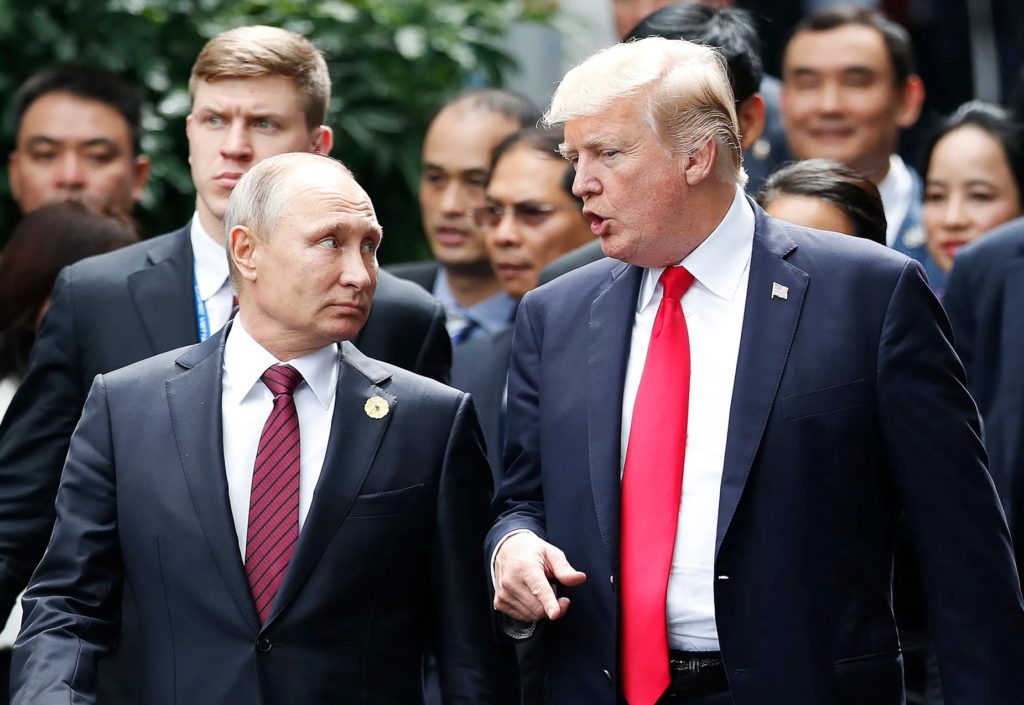
New Emerging Scenario and Options for Turkey
After the joint statement it is feared that if Ankara launches a military operation against Afrin without consent from both countries it is likely to get not so friendly gesture/response from them. Russia has a military presence in Afrin and had signaled earlier in the year that it would support the YPG against a potential Turkish intervention. The U.S. has relied on the YPG as a ground force against the ISIS and provided it with military equipment despite repeated Turkish outcry. Turkey objected to PYD’s participation in Geneva.
Turkey’s efforts to talk Moscow into excluding the PYD from the congress has so far been unsuccessful, as Moscow recently said it favors the participation of all parties in the Syrian conflict. In addition, the U.S. – Russian statement treats Syrian President al-Assad as a legitimate actor by referring to his commitment to the Geneva peace process, constitutional reform and elections.
Expected Change of Turkish Foreign Policy towards Syria
It is now high time for Turkey to review its foreign policy towards Syria especially and consolidate its military advantages and refrain from further operations until the situation on the ground becomes clearer. But Ankara and Moscow have agreed that it is now time to focus on a political solution in Syria.
New End Game
A new end game in Syria has been started since long. Regional countries, Turkey, Saudi Arabia, Iran, Egypt and even Lebanon have been engaged in turf wars for the last many years. International power brokers, movers and shakers have been playing the people of Syria in order to secure their own vested socio-economic, geopolitical and geo-strategic interests which are conflicting and compounding.
Syria, one country has too many claimers of the government and its people. Syrian, one soil has too many divisions. Syria, not one nation has been divided into so many faction groups and has already been declared as the deadliest crisis of the 21th century. Syria once was the Venice of the Middle East, now it has been turned into rubble. Syria once was a place of comfort and hospitality but has now been overwhelmed with many confrontations and horrendous crimes against humanity. Syria has now become battel field for regional proxies among Saudi Arabia, Iran, Turkey, ISIS and Al Qaeda. Syria has also become playing field for international rivalries between the US and the Russia.
The Syrian crisis started with the dawn of the so called “Arab Sprig” and escalated into full fledged civil war which encouraged many regional countries to use their hidden arms to participate in the ongoing war for their own interest. Syria has now unfortunately become a safe haven for global jihadism where ISIS and its global sanctuaries are fighting for their survival.
The Syrian war has produced a global refugees crisis where common Syrians are fleeing into other regional countries, Turkey, Jordan, Egypt, UAE and European Countries i.e. Germany, France, Spain and many more.
Figure I shows Syrian war internal dynamics which is influenced by difference of faith, vested interest, ethnicity, discrimination, violation of human rights and the last but not the least, foreign funding or “economic terrorism” to win the war of survival.
Internal Dynamics of Syrian War Theater
Figure l
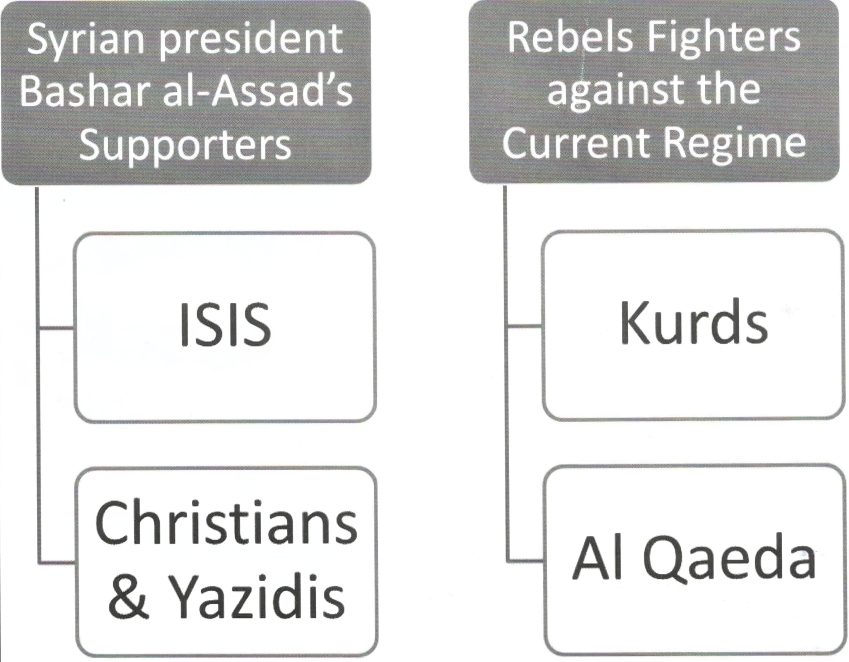
It also shows that the Syrian nation has now divided into so many domestic stake holders which are playing their dirty power politics to win the war at any cost. There are the soldiers who support the Syrian president Bashar al-Assad, there are other fighters, called rebels who do not want Assad to be in power anymore. ISIS has been in the front seat to fight against Assad. The Kurds are fight for their survival whereas Christians, Yazidis and fragmented Al Qaeda are coordinating with ISIS in the different parts of Syria. ISIS had taken over large parts of Iraq and then moved into eastern Syria. In the chaos of the war they were able to gain land and power there too.
Raqqa was the first big city captured by ISIS in Syria in early 2014. The group succeeded to capture large parts of the country towards Aleppo in the north, and along the Turkish border. Thanks to rebel resistance funded by many regional countries, ISIS has lost control of most it. Most recently, an alliance of Syrian Kurdish and Arab fighters, backed by America, took back the city of Raqqa in the north-west which ended three years of rule by ISIS who had made Raqqa their headquarters.
figure II shows “geography of power” in Syria where conflicting ground realities do not care about humanity. The city of Deir al-Zour (4th largest city in Eastern Syria) has also been retaken from the ISIS by the Syrian Army. It had strategic importance to ISIS because of its close border with Iraq.
Figure ll
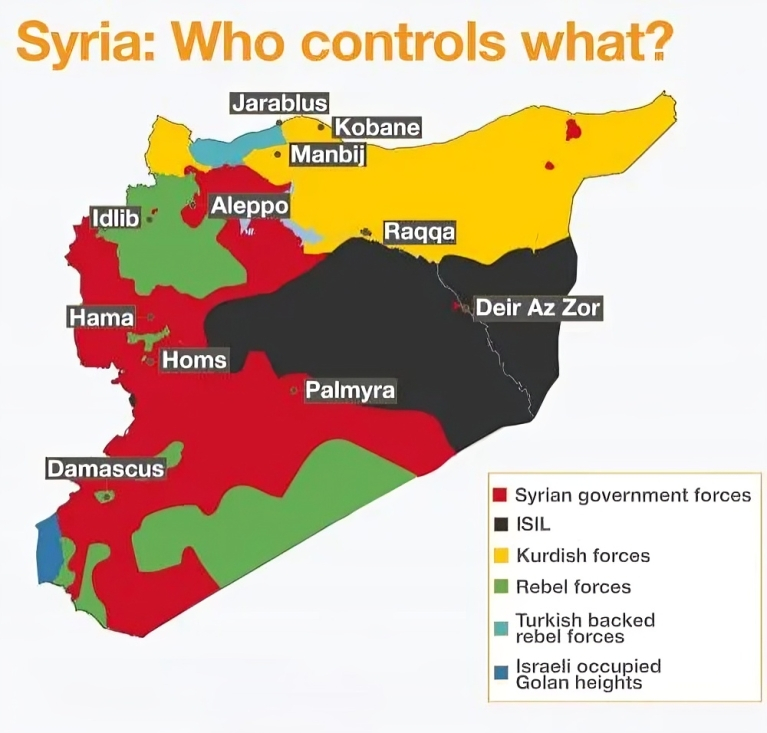
Rebels still control smaller areas in the central province of Homs, the southern provinces of Deraa and Quneitra, and the eastern Ghouta agricultural belt outside Damascus. Kurdish forces, meanwhile control much of Syria’s border with Turkey, as well as a large part of the country’s north-east.
figure III shows that Syrian crisis began in 2011 in the Syrian city of Deraa. It started because local people decided to protest after 15 school children were arrested and reportedly tortured for some anti-government activities. Initially, the protests were peaceful calling for the release of the children, democracy and greater freedom for people in the country. The Assad government responded angrily and the army opened fire on protesters, killing four people. Subsequently, people were extremely shocked and angry and soon the unrest spread to other parts. At first, the protesters just wanted democracy and greater freedom but afterwards they demanded President Bashar al-Assad’s resignation. However, he refused to do this which made the protesters extremely angry. Resultantly, internal fighting erupted in different prats of Syria and produced havocs. Ultimately, it became a civil war during July 2012. What began as a peaceful uprising against Syria’s President Bashar al-Assad six years ago became a full-scale civil war that has left more than 400,000 people dead, devastated the country and drawn in global powers.
Start of Syrian War
Figure lll
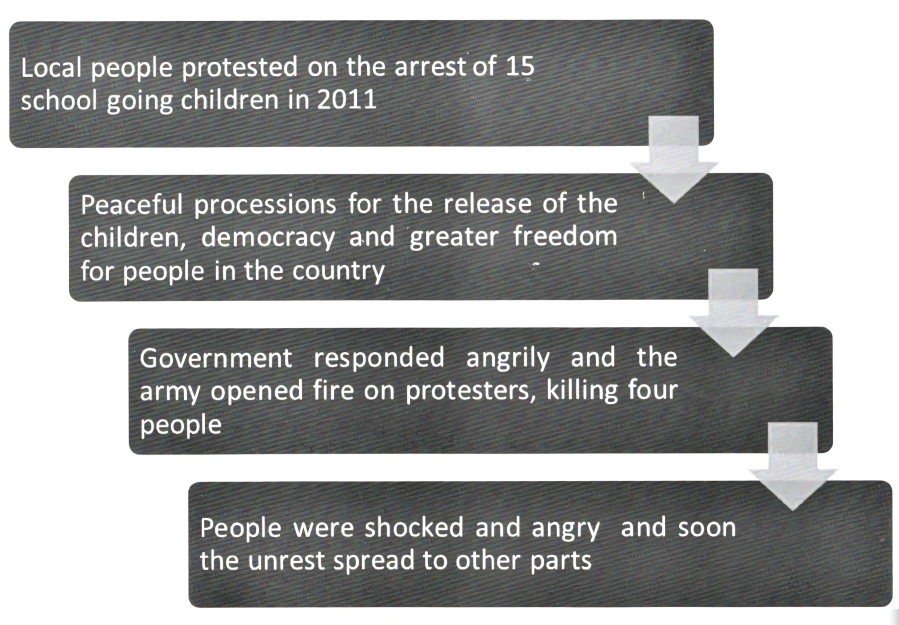
The city of Homs, dubbed “the capital of the revolution” suffered widespread destruction. The violence rapidly escalated and the country descended into civil war as hundreds of rebel brigades were formed to battle government forces for control of the country. Assad’s government forces lost control of large swathes of the country to various armed groups.
Initially, there are two groups in Syria fighting for supremacy and survival. One was headed, financed and patronized by the government. The other group called the Opposition consisted of “the rebels, political parties, civil society and students” who dared to disagree with Assad. Initially there were more than 1,000 different groups opposed to the government with an estimated 100,000 fighters.
Strategic Point “Involvement of ISIS”
ISIS which had extreme, violent views joined the rebellion against President Bashar al-Assad where it found safe havens and easy access to weapons. They also persecuted other groups, including Christians and Yazidis and succeeded in capturing large areas in Iraq and Syria, especially its eastern part during 2014. In September 2014 the US used planes to attack IS fighters in Iraq. ISIS controlled large swathes of northern and eastern Syria, was battling government forces, rebel brigades and Kurdish militias, as well as facing air strikes by Russia and a US-led multinational coalition.
Domestic Conflicting Parties
Figure lV
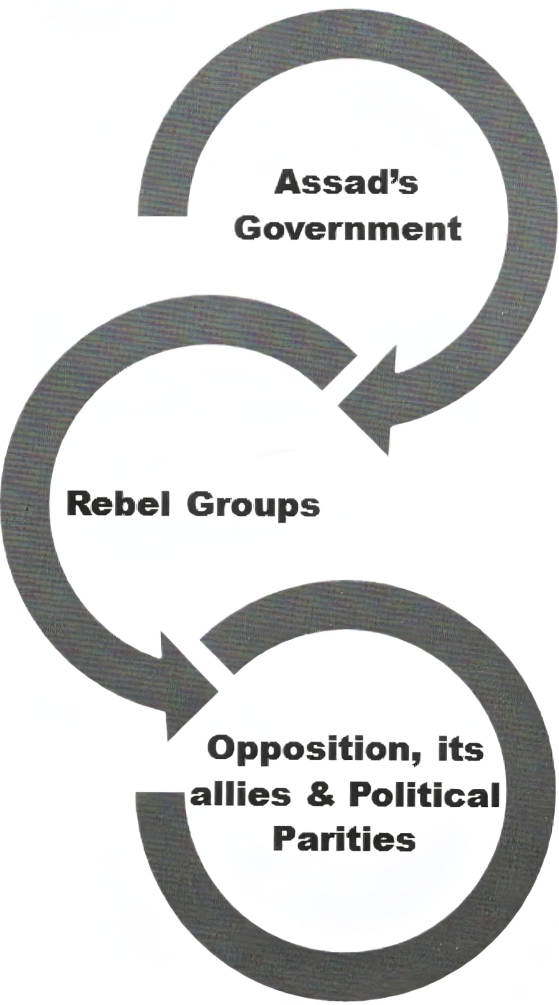
AL Qaeda’s Sanctuary
The global franchise of Al Qaeda also indulged in the war of Syria and tried to capture and maintain its strongholds in different parts of the country. Jihadist groups cashed on sever sectarian and ethnicity division of Syrian society and Al Qaeda led group Al-Nusra Front, controlled large parts of the north-western province of Idlib. Shia dominated group “Hezbollah” supported Assad’s government and battled out. Thousands of Shia militiamen from Iran, Lebanon, Iraq, Afghanistan and Yemen fought against other militant groups like ISIS and Al-Qaeda allegedly trained, financed and patronized by Sunni led countries like Saudi Arabia, Turkey, Egypt, Jordan and the UAE.
Composition of Rebels Groups in Syria
By studying different research papers and regional dailies, there were five rebels groups fighting each other in different parts of Syria since 2011. The rebels groups are given below as:-
figure V shows different doctrines, faiths, sects and ethnic groups fighting along with local rebels groups in different parts of Syria. Ironically, Israel, which does not fit into any of the above, is most closely aligned with members of the first grouping in Syria.
Several Arab states, along with Turkey, have provided weapons to rebel groups in Syria. The governments of majority-Shia Iran and Iraq support Assad, as does Lebanon-based Hezbollah, while Sunni-majority states including Turkey, Qatar, Saudi Arabia and others staunchly supported the rebels.
Figure V
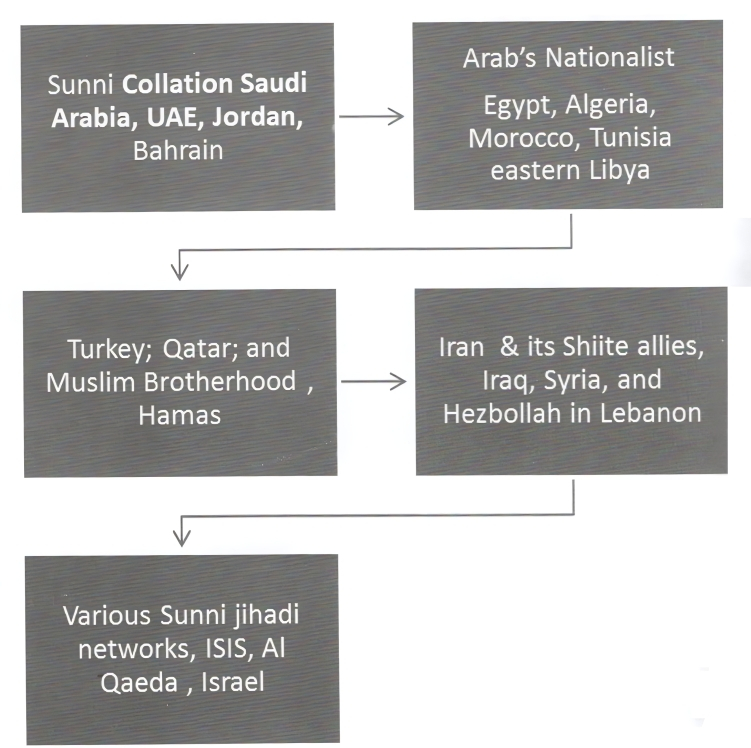
Foreign Intervention
World powers including Iran, Turkey, Russia, Saudi Arabia and the United States intervened in the internal affairs of Syria which trigged the war due to which many regional countries are now facing spillover repercussions of it. Their military, financial and political support for the government and opposition contributed directly to the intensification and continuation of the fighting, and turned Syria into a proxy battleground.
External powers have also been accused of fostering sectarianism in what was a broadly secular state, pitching the country’s Sunni majority against the president’s Shia Alawite sect. Such divisions have encouraged both sides to commit atrocities that have not only caused loss of life but also torn apart communities, hardened positions and dimmed hopes for a political settlement.
Regional & International Countries Involvement
| Countries | Main Motives | Interests |
| Iran | Further strengthening of Shia’s Crescent in the region. | Iran spent billions of dollars to bolster the Alawite-dominated government, provided military advisers and subsidized weapons, as well as lines of credit and oil transfers. It reported to have deployed hundreds of combat troops in Syria. |
| Saudi Arabia | Further strengthening of Sunni domination in the region and marginalization of Shia’s Crescent in the region. | Organized militia struggle in Syria by organizing different rebel groups by financing and projecting sectarian and ethnicity. |
| Turkey | Marginalization of Iran influence in the region and making its Syrian boarders safer. | It used Kurds against Assad’s government as well as ISIS to achieve its vested interests. |
| US | To topple Assad’s regime | Supplied arms to rebels groups, financed them and started airstrikes to punish and stop onslaught of Iran in the region. |
| Russia | To safe Assad’s government | Started airstrikes for stabilizing Assad government and succeeded to do so. Moreover, once again stop the US for its regional as well as global hegemony. |
Russian Support
Russia recued the weak government of Assad and provided it crucial strategic space for political maneuverings. Russia’s air campaign aimed to “stabilise” the government of President Bashar al-Assad. President Assad’s survival was critical for Russia to maintain its interests in Syria, launched an air campaign in September 2015 with the aim of “stabilising” the government after a series of defeats. Moscow stressed that it would target only “terrorists”, but activists said its strikes mainly hit Western-backed rebel groups. It proved effective and played a major role in the government’s siege of rebel-held eastern Aleppo, which fell in December 2016.
The US claimed President Assad was responsible for widespread atrocities, provided only limited military assistance to “moderate” rebel groups. The US conducted air strikes on ISIS in Syria since September 2014. The US government has always showed its displeasure and dissatisfaction to the Assad’s regime but in the past, it refrained from any direct conflict with Syria even after the Assad government allegedly used chemical weapons in 2013, which former US President Barack Obama had referred to as a “red line” that would prompt intervention. In October 2015, the US scrapped its controversial programme to train Syrian rebels, after it was revealed that it had spent $500m but only trained 60 fighters. The CIA allegedly froze funding and logistical support to rebel’s group of Syria in February 2017. On April 7, the US carried its first direct military action against Assad’s forces, launching 59 Tomahawk cruise missiles at a Syrian air force base from which US officials believed a chemical attack in Khan Sheikhoun had been launched.
Figure Vl

Russia launched a bombing campaign against what it referred to as “terrorist groups” in Syria, which included ISIL as well as rebel groups backed by western states in September 2015. Russia also deployed military advisers to shore up Assad’s defences. At the UN Security Council, Russia vetoed eight Western-backed resolutions on Syria, while China vetoed six resolutions.
Turkey remained a staunch supporter of the rebels but wished to contain the Kurdish Popular Protection Units (YPG) militia whose fighters fought against ISIS as part of the US-backed Syrian Democratic Forces (SDF) alliance. Ankara accused the YPG of being an extension of the banned Turkish Kurdistan Workers’ Party (PKK).
Turkish troops and special forces backed by the Free Syria Army, launched in August 2016 operation “Euphrates Shield” against ISIL to liberate the strategic Syrian city of Jarablus on the border with Turkey and to stop the advance of Kurdish militia fighters. Turkey’s government feared its large native Kurdish population might grow more restive and demand greater autonomy as a result of increased Kurdish control in northeast Syria.
Emerging Turkish Realization
Right from the beginning, Turkey was more focused on the realpolitik than triumphalism. Ankara has had to give up its support for Sunni rebels trying to topple the Assad regime, and move towards Russia and Iran to prevent Syrian Kurdish fighters allied with insurgent Turkish Kurds from consolidating a self-governing entity along its borders.
Israel also carried out air strikes inside Syria, the latest of which was on Damascus and Quneitra. Israel and Syria are technically at war since 1948, but the border remained largely quiet since 1973.
New National Players
Syrian crisis started in 2011 and the saga continues even today. Many new rebel groups have joined the fighting in Syria, including ISIL, Jabhat Fateh al-Sham, Iran-backed Hezbollah, and the Syrian Democratic Forces (SDF) dominated by the Kurdish People’s Protection Units (YPG). As the war prolonged, the Free Syrian Army (FSA) has become weak while other militant groups i.e. al-Nusra Front became empowered. Al-Qaeda has also further strengthened. Lebanese members of Hezbollah are fighting on the side of Assad, as are Iranian and Afghan fighters.
Figure Vll
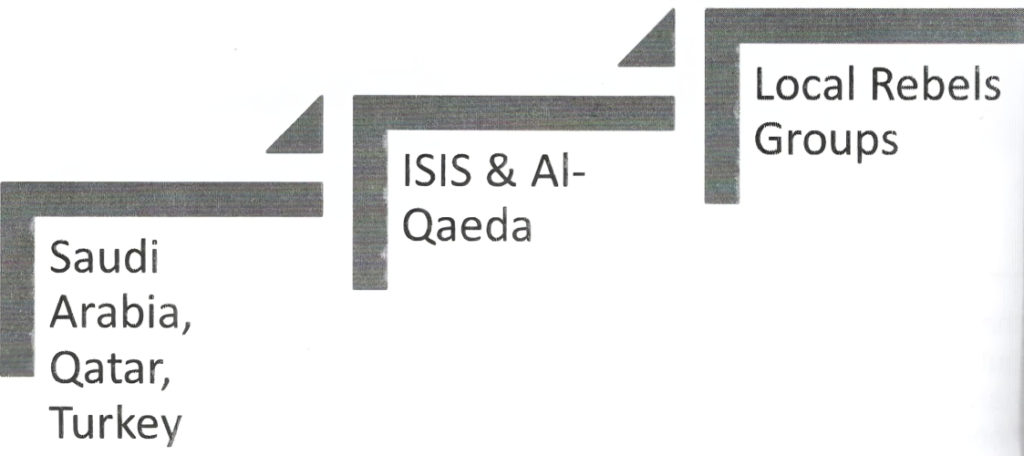
Rising Shia’s Crescent and Future Emerging Scenarios
It seems that victory in Aleppo cemented its Shia crescent in the region i.e. from Baghdad to Beirut. But the US immediately revisited its policy towards Iran and its regional allies and it threatened to tear up or make unworkable the nuclear deal Iran. It is predicted that ISIS in Iraq and Syria would probably collapse but not totally wipe-out in 2017. Assad will still survive because of having functional air force and backing of regimes in Iraq, Iran and Lebanon.
Complicated & Complex
The emerging geo-political and geo-strategic scenarios are complicated and complex in its nature, scope and utility. Friends have become foes, allies have become aliens, and the last but not the least, compromises have become confrontations. The Iraqi Kurds, who have reasonably good relations with Turkey but the Turkish government is vehemently opposed to any kind of independent Kurdish state in northern Syria. But the U.S. – led coalition overwhelmingly relies on Kurdish ground forces in Syria, and they hold most of the ground cleared from the ISIS. Conflicting ground realities has created great confusion.
Losers
The government of Assad succeeded in deploying allies who were willing to fight: Iran, Russia, and Hezbollah units became engaged on the tactical and strategic level. These units were better led and better trained than the rebels. With the fall of Aleppo the final nail in the coffin of the insurgency had been hammered in 2016.
Winners
It is obvious that Russia, Iran, Hezbollah, Iraq and Lebanon have emerged victorious in the Syrian War. Russia strongly resisted westernized change of power in the Middle East and it used comparatively better war strategy to stabilize weakening regime of Assad. Russia’s air force was well-integrated with the ground operations of Iran and Syrian militias. Iran’s efforts also paid big dividends. It saw from the beginning that the regime change project in Syria was a covert attempt by so many regional countries and regional power brokers. It is hoped reconstruction of Syria may be granted to China and its private companies which also labeled it as victor.
Figure Vlll
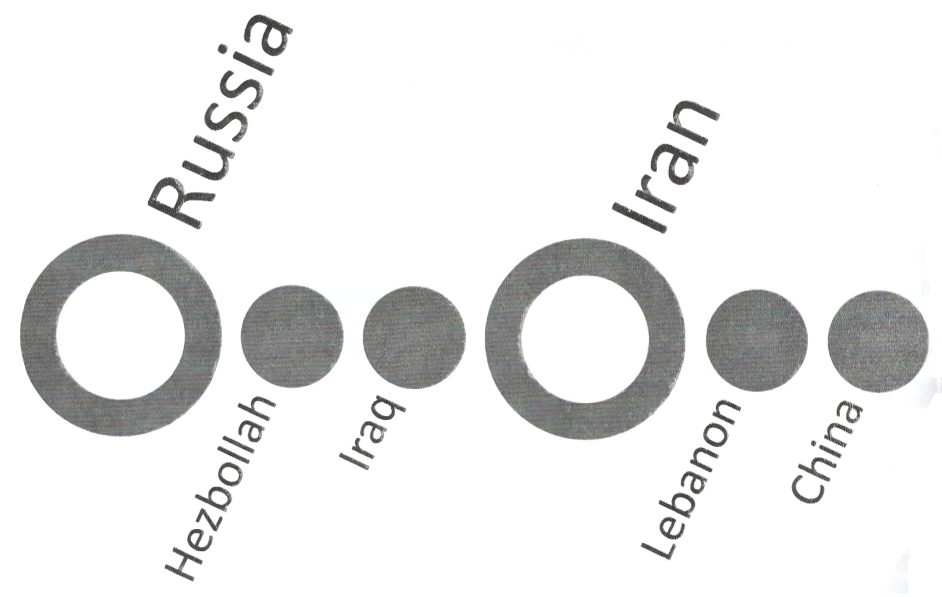
Conclusion
Syria, the holy land has become a battle field of horrendous proportions. Syria, the birth place of so many prophecies has been misused by so many attackers. After years of civil war, Syria is now a country that lies in ruins. Thousands have died, millions have fled. With no end of the war in sight, groups continue to battle for control over large parts of the country.
The Assad’s government, the ISIS, Al-Qaeda, Kurdish factions, and several other rebel groups are still fighting for some of the most important parts of the country. Government troops, supported by Russian war planes, have gained some ground over the past few months, expelling ISIL from Palmyra, Raqqa and other important places. Somehow, the Syrian government managed to capture Aleppo, one of the main battlegrounds in the conflict in 2016. The Kurdish fighters made gains in the northern part of Syria, reducing the territory under control by ISIS.
Russia wants to achieve a sustainable ceasefire and afterwards, labeling of it as frozen conflict. Turkey holds the key of its success to getting armed opposition groups to agree. But a permanent political solution is far away. Turkey may not be knocked out, but its role may be geographically circumscribed to certain parts of northern Syria because rise to Kurds. Iran is not fully happy with the Russian-Turkish approach today, as it wants a clearer and firmer victory for Assad, but it is smart enough to bide its time. It is the power on the ground and also the key for any serious future politics.
Iran’s clout in the Middle East will be further strengthened. In Syria, Iran mustered the Shia fighters who helped save the regime of Bashar al-Assad, enabling him to start reconquering lost lands. On September 5th Syrian soldiers and Iranian-backed militiamen relieved the garrison in the eastern city of Deir ez-Zor, which had been besieged by the so-called Islamic State (IS) since 2014. The advance brings Iran close to securing an overland route that would run from Tehran, via Baghdad, to the Mediterranean. This would make it much easier for it to supply Hezbollah with arms and fighters from Iraq, Afghanistan and other countries.
Syrian crisis has also a human aspect. The UN says at least 450,000 people have been killed in the past six years. Five million people most of them women and children have fled Syria. Neighbouring Lebanon, Jordan and Turkey have struggled to cope with one of the largest refugee exoduses in recent history.
About 10 percent of Syrian refugees have sought safety in Europe, sowing political divisions as countries argue over sharing the burden. A further 6.3 million people are internally displaced inside Syria. The UN estimates it will need $3.4bn (£2.7bn) to help the 13.5 million people who will require some form of humanitarian assistance inside Syria in 2017.
Almost 85 percent of Syrians live in poverty, with more than two-thirds of the population in either extreme or abject poverty. More than 12.8 million people in Syria require health assistance and more than seven million are food insecure amid rising prices and food shortages. Households spend up to a quarter of their income just on water. Some 1.75 million children are out of school. Almost half of Syria’s pre-war population of 23 million has been displaced by the war. The warring parties have compounded the problems by refusing humanitarian agencies access to many of those in need. Some 4.9 million people live in besieged or hard-to-reach areas.
The Syrian conflict has created one of the worst humanitarian crises. Families are struggling to survive inside Syria, or make a new home in neighboring countries. Others are risking their lives on the way to Europe, hoping to find acceptance and opportunity. And harsh winters and hot summers make life as a refugee even more difficult. At times, the effects of the conflict can seem overwhelming.


